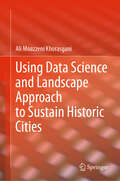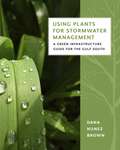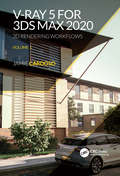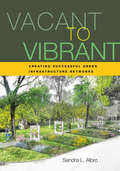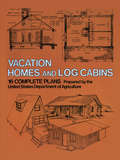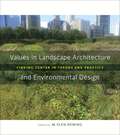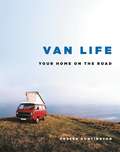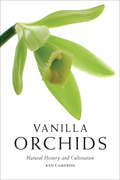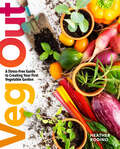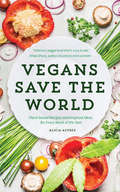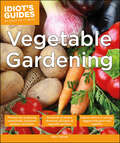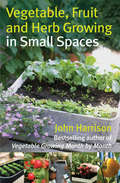- Table View
- List View
Using Data Science and Landscape Approach to Sustain Historic Cities
by Ali Moazzeni KhorasganiThis book comprehensively explores sustaining historic cities using a landscape approach and data science. The author offers valuable insights for professionals and enthusiasts interested in preserving and developing urban heritage through a data driven approach. Drawing on the synergy between landscape architecture and data science, the book delves into the intricate interplay between historical, cultural, and environmental factors in urban settings. Readers will understand how to navigate historic cities' complex challenges through case studies, research findings, and practical methodologies. The book equips readers with innovative strategies for preserving the authenticity of these cities while embracing sustainable development practices. By blending theory and real-world applications, this book is a comprehensive guide for creating thriving, resilient, and culturally rich urban environments.
Using Plants for Stormwater Management: A Green Infrastructure Guide for the Gulf South
by Dana Nunez BrownThe subtropical climate of the Gulf South supports a varied abundance of flora, and this diversity is sustained by the ample amount of rainwater that characterizes the region. Managing rainwater in a planned environment and mitigating its effect on human habitation can test the skills of even the most seasoned landscape architect or designer. That challenge has never been more acute as increased human demand for natural resources compels professionals and home gardeners alike to seek out sustainable ecological solutions.In this guidebook, Dana Nunez Brown details ways to manage each drop of rainwater where it falls, using a cost-effective and environmentally sensitive approach. Under natural conditions, rainfall primarily percolates into the ground and flows as groundwater until it is absorbed by trees and other vegetation, after which it is evaporated into the atmosphere and the cycle starts anew. Brown identifies plants and techniques that leverage this natural process in order to filter, clean, and slow runoff, a practice known as Low Impact Development. Using Plants for Stormwater Management presents the native ecological communities and plant species of the Gulf South in easy-to-follow sections and diagrams. Information ranging from the productiveness of root structures and the compatibility of plants with local soils to the optimal elevation of specific vegetation and the average dimensions of foliage is represented by graphic icons for quick and easy identification. An accessible and essential resource, this book gives both novices and experts the know-how to harness rainfall and create beautiful, ecologically functioning landscapes.
Utopian England: Community Experiments 1900-1945 (Planning, History and Environment Series)
by Dennis HardyEngland in the early part of the twentieth century was rich in utopian ventures - diverse and intriguing in their scope and aims. Two world wars, an economic depression, and the emergence of fascist states in Europe were all a spur to idealists to seek new limits - to escape from the here and now, and to create sanctuaries for new and better lives.Dennis Hardy explores this fascinating history of utopian ideals, the lives of those who pursued them, and the utopian communities they created.Some communities were fired by a long tradition of land movements, others by thoughts of more humane ways of building towns. In turn there were experiments devoted to the arts; to the promotion of religious doctrine; and to a variety of political causes. And some were just 'places of the imagination'.Utopian England is about just one episode in the perennial search for perfection, but what is revealed has lessons that extend well beyond a particular time and place. So long as there are failings in society, so long as rationality is not enough, there will continue to be a place for thinking the impossible, for going in search of utopia.
Utopias and Architecture: Reconsidering Architecture And Utopia (Ralahine Utopian Studies #8)
by Nathaniel ColemanUtopian thought, though commonly characterized as projecting a future without a past, depends on golden models for re-invention of what is. Through a detailed and innovative re-assessment of the work of three architects who sought to represent a utopian content in their work, and a consideration of the thoughts of a range of leading writers, Coleman offers the reader a unique perspective of idealism in architectural design. With unparalleled depth and focus of vision on the work of Le Corbusier, Louis I Kahn and Aldo van Eyck, this book persuasively challenges predominant assumptions in current architectural discourse, forging a new approach to the invention of welcoming built environments and transcending the limitations of both the postmodern and hyper-modern stance and orthodox modernist architecture.
V-Ray 5 for 3ds Max 2020: 3D Rendering Workflows Volume 1 (3D Photorealistic Rendering)
by Jamie CardosoIncrease the photorealism of your 3d visualizations with enhanced toolsets of V-Ray 5 for 3ds Max 2020. The book is filled with colorful illustrations depicting step-by-step tutorials about the process of creating a photorealistic day-and-night exterior scene. Each tutorial includes a 3d project scene to guide users through the production and the post-production processes. The book begins with an overview of the best techniques to approach clients via emails, calls, meetings, and via social media. There are also key insights into the best practices of handling projects, pricing, contracts, invoices, the pre-production, production, and the post-production, to name but a few. Throughout the book, users are taken through VRayMtl functions such as Diffuse, Roughness, Reflect, Glossiness, Metalness, Refract, Index of Refraction (IOR), Abbe number, Fog color, Translucency, BRDF, Coat, Sheen, and Bump. Also, users will learn how to use procedural maps such as VRayBitmap, VRayTriplanarTex, Bricks, Metals, Carpaint, VRayDisplacementMod, VRayUVWRandomizer, VRayMultiSubTex, VRayPointCloudColor, VRayDirt, VRayAerialPersepective, VRayLightMtl, VRayMtlWrapper, VRayOverrideMtl, VRay2SidedMtl, VRayBlendMtl, and VRayEdgesTex. In addition, there are tips and tricks accompanied with videos highlighting how to create VR interactive apps using Verge 3d; how to create verified views; and how to use plug-ins and scripts such as Project Manager, Auto grid pivot point, GarageFarm, Zmapping, gobotree, and VIShopper. Finally, users will have a rare insight into all functionalities of a VRay camera, VRayLight objects, Render settings, Frame buffer, Global switches, IPR options, Bucket and Progressive image samplers, Image filters, Global DMC, Color mapping, Brute force global illumination, Light cache, Color management, Distributed rendering, Render elements, VRay image file format, VFB History settings, VFB Lens Effects, LightMix, Film tonemap, Hue/Saturation, Lookup Table, and much more. Key Features This book deals with real projects/3d scenes and delivers up-to-date V-Ray 5 functionalities and production workflows using 3ds Max 2020 This book has professional supporting files ready to open and explore This book details the meticulous step-by-step processes of creating jaw-dropping 3d renderings This book includes unrivaled in-depth coverage of V-Ray 5 for 3ds Max 2020 This book includes 3d rendering methodologies currently used by key industry players Author Jamie Cardoso is a renowned author, reviewer, computer artist, and technologist, with years of experience in creating state-of-the-art 3d photomontages, verified views, VR, AR, XR, MR, Stereos, and photorealistic interior and exterior visualizations for architects and designers.
Vacant to Vibrant: Creating Successful Green Infrastructure Networks
by Sandra AlbroVacant lots, so often seen as neighborhood blight, have the potential to be a key element of community revitalization. As manufacturing cities reinvent themselves after decades of lost jobs and population, abundant vacant land resources and interest in green infrastructure are expanding opportunities for community and environmental resilience. Vacant to Vibrant explains how inexpensive green infrastructure projects can reduce stormwater runoff and pollution, and provide neighborhood amenities, especially in areas with little or no access to existing green space.Sandra Albro offers practical insights through her experience leading the five-year Vacant to Vibrant project, which piloted the creation of green infrastructure networks in Gary, Indiana; Cleveland, Ohio; and Buffalo, New York. Vacant to Vibrant provides a point of comparison among the three cities as they adapt old systems to new, green technology. An overview of the larger economic and social dynamics in play throughout the Rust Belt region establishes context for the promise of green infrastructure. Albro then offers lessons learned from the Vacant to Vibrant project, including planning, design, community engagement, implementation, and maintenance successes and challenges. An appendix shows designs and plans that can be adapted to small vacant lots.Landscape architects and other professionals whose work involves urban greening will learn new approaches for creating infrastructure networks and facilitating more equitable access to green space.
Vacation Homes and Log Cabins
by U.S. Dept. of AgricultureUsing five basic construction techniques: conventional wood-frame, A-frame, pole-frame, concrete masonry, and log cabin, here are 16 complete plans for cabins, vacation homes, and low-cost permanent homes. Designed for economy of material and labor and for efficiency and usefulness, the buildings range from a 10' by 14' one-room cabin with front porch to a two-bedroom tenant house. Also included are plans for a three-room frame cabin, 14' by 18' frame cabin, 24' by 24' frame cabin, 24' by 24' concrete-block cabin, two-bedroom frame cabin with sleeping loft, 24' by 36' A-frame vacation home, all-purpose 24' by 24' A-frame cabin, two five-room log cabins, three-room log cabin, one-bedroom pole-frame cabin, one-room pole-frame cabin, and a two-bedroom frame vacation home. Preceding each plan is a sketch of the finished building and a floor plan. Hints on construction, materials, location, and use are given as well as alternative floor plans, heating and plumbing systems, possible installments and additions, suggestions for roofing, siding, etc. These sixteen plans were compiled by the Cooperative Farm Building Exchange. All of the plans and buildings have been tested and approved by the U.S. Department of Agriculture.
Values in Landscape Architecture and Environmental Design: Finding Center in Theory and Practice (Reading the American Landscape)
by M. Elen DemingThe successful realization of diversity, resilience, usefulness, profitability, or beauty in landscape design requires a firm understanding of the stakeholders' values. This collection, which incorporates a wide variety of geographic locations and cultural perspectives, reinforces the necessity for clear and articulate comprehension of the many factors that guide the design process. As the contributors to this collection reveal, dominant and emerging social, political, philosophical, and economic concerns perpetually assert themselves in designed landscapes, from manifestations of class consciousness in Napa Valley vineyards to recurring themes and conflicts in American commemorative culture as seen in designs for national memorials. One essay demonstrates the lasting impact of the doctrine of Manifest Destiny on the culture and spaces of the Midwest, while another considers the shifting historical narratives that led to the de-domestication and subsequent re-wilding of the Oostvaardersplassen in the Netherlands. These eleven essays help foster the ability to conduct a balanced analysis of various value systems and produce a lucid visualization of the necessary tradeoffs. Offering an array of case studies and theoretical arguments, Values in Landscape Architecture and Environmental Design encourages professionals and educators to bring self-awareness, precision, and accountability to their consideration of landscape designs.
Van Life: Your Home on the Road
by Foster HuntingtonShowcasing hundreds of funky vehicles, awe-inspiring landscapes, and cleverly designed interiors in tiny spaces from around the world, Van Life is perfect for who anyone daydreams about living on the open road.More and more people-from millennials to baby boomers-are taking a break from conventional life for the freedom, tranquility, and adventure of being on the road and living in a converted vintage truck, camper, or van.One of these vandwellers, Foster Huntington, created the #vanlife hashtag as he chronicled his adventures living in a van while driving it across the country. He tapped into a community of like-minded individuals looking to explore nature at their own pace and live a debt-free lifestyle.Van Life showcases the best crowd-sourced photographs from Foster's tumblr account, van-life.net, many of which have never been posted. Organized into sections like Volkswagen vans, American vans, converted vans, school buses, and more, the hundreds of photos include shots of the unique vehicles, the beautiful locations they've been parked including stunning beaches, dramatic mountains and picturesque forests, fully designed interiors with kitchens and sleeping quarters, and more.Also included are interviews with solo travelers, couples, and families who are living this new American dream.
Vanilla Orchids: Natural History and Cultivation
by Ken CameronWith more than 30,000 known species, orchids represent the largest family of plants. But only one genus has agricultural value—the Vanilla orchid. Leading orchid expert Ken Cameron covers the natural history of the world’s most popular flavor and fragrance and provides an introduction to the pollination, biology, structure, evolution, and diversity of Vanilla and related orchids. Vanilla Orchids also features methods for bean harvest, curing, and processing for enthusiasts who want to try it at home.
Vanlife Diaries: Finding Freedom on the Open Road
by Kathleen Morton Jonny Dustow Jared MelroseA photography book celebrating the nomadic lifestyle and community of vanlife through interviews, essential advice for living on the road, and more than 200 photos of tiny rolling homes.Inspired by the blog and Instagram account, Vanlife Diaries is an inspiring and detailed look into the world of the rolling homes built and occupied by a new generation of modern nomads: a range of professionals and creatives who have ditched conventional houses for the freedom of the road and the beauty of the outdoors. More than 200 photographs feature the vanlifers, their pets, and their converted vans and buses--VWs, Sprinters, Toyotas, and more--with the interiors uniquely customized and decorated for their work and hobbies, as well as the stunning natural locations that are the movement's inspiration. Interviews and narrative captions share the stories of these nomads and how they decided to pursue vanlife, and provide practical tips and inspiration for downsizing, finding and converting your vehicle, and working and living on the road.
Veg Out: A Stress-Free Guide to Creating Your First Vegetable Garden
by Heather RodinoBeginner vegetable gardeners won&’t end up in the weeds with this accessible guide. Watching delicate seedlings sprout from the ground and plucking cute cherry tomatoes at the peak of ripeness—if this is your idea of living the dream, you&’ll want this friendly guide. Gardening expert Heather Rodino teaches the basics of growing your own vegetables, such as how to choose the right plants for a climate and guarding the crop from hungry critters. Included are 30 profiles of beginner-friendly vegetables and herbs with detailed instructions on where to grow, when to harvest, as well as their sunlight, watering, and soil needs. With helpful tips and photographs of important concepts, Veg Out is the perfect companion for any budding vegetable gardener.
Veg in One Bed New Edition: How to Grow an Abundance of Food in One Raised Bed, Month by Month
by Huw RichardsGrow your own vegetable garden with this practical, straightforward gardening guide.There is nothing more fulfilling than growing your own home produce. You don't have to be a seasoned gardener to produce a healthy, flourishing garden - all you need is a few seeds, water, sunlight, good advice and patience!In just one raised bed, author Huw Richards, shows you exactly how to grow vegetables organically, abundantly and inexpensively so you have something to harvest every month of the year. Here's what you'll find inside:- Month-by-month guide to what to do and how to do it, including what pests to look out for, and what can be harvested. - Covers first year in detail, with the final chapter on &‘Next Steps&’ providing suggestions of what to do in years two and three.- Illustrations show you what the bed should look like month to month.- Windowsill planting ensures early success cultivating plants before they are transferred into the bed.- Maintenance sections ensure readers know how to keep their plants (and raised bed) healthy each month.- Includes instructions on assessing your site and building a 4x10ft (1.2x3m) raised bed.- Alternative vegetables are recommended, allowing readers to tailor their bed to their taste.- Plans chart growing season for different circumstances: cool climate, low rainfall, low effort, salad bed, winter bed, herbs and edible flowers.Month by month, discover what you need to do and how to do it. Try becoming more self-sufficient in your allotment, a small garden, or even on a roof terrace. Veg In One Bed shows you that you can have a small thriving garden and still be able to maintain it, yielding fresh vegetables all year round. Learn what to do each month on your windowsill, where you'll raise seedlings, and in your raised bed, where your plants will grow to maturity. Everything is explained in clear, illustrated steps: building your bed, growing from seed, planting, feeding, and harvesting.This gardening book not only guides you through the whole process of building your raised bed through to harvesting your vegetables but also provides sustainable gardening practices, which will resonate with all gardeners committed to protecting our planet. This makes for the perfect book for new gardeners who want to grow their own produce, as well as the new generation of gardeners who are seeking a gardening guru of their own age.Veg in One Bed goes beyond the inspiring demonstrations on his YouTube channel "Huw Richards - Grow Food Organically". In this book he organizes all his ideas and suggestions into a blueprint for growing your own vegetables month by month. Little growing experience? Only a small space? No matter - with Veg in One Bed, you can still eat food you have grown all through the year.
Vegan Style: Your Plant-based Guide to Fashion * Beauty * Home * Travel
by Sascha CamilliCalling all compassionate consumers—now you can become completely cruelty-free with this inspirational guide to vegan products, brands, and materials to help you look good and live kindly. Going vegan doesn&’t just apply to the food you eat—now you can veganize all aspects of your life from beauty products to fashion to homeware. And with so many ethical, environmentally friendly products on the market today, you no longer have to sacrifice style for sustainability. Vegan Style offers a healthy dose of luxurious lifestyle inspiration for people who want to live kindly, feel good, and look fabulous. With insight and advice from today&’s most creative and innovative vegan fashion designers and influencers, discover how you can incorporate more cruelty-free brands to your wardrobe while still looking great. Plus, get some pointers from vegan experts on homeware, grooming products for men, and plant-based places to travel. We&’ve got your entire vegan lifestyle covered!
Vegans Save the World: Plant-based Recipes and Inspired Ideas for Every Week of the Year
by Alicia AlvrezMake the transition to healthy, clean-eating, planet-friendly vegan with this unique cookbook and guide full of “tips for ditching animal-based products”(Billee Sharp, author of Lemons and Lavender).In this combination cookbook and lifestyle guide, Alice Mary Alvrez shares her journey from not-so-healthy carnivore to urban homesteader who turned her health around and contributes to a healthier planet as well. This utterly unique vegan cookbook offers over one hundred easy-to-make vegan recipes, and Alvrez also shares her green-living methods, cooking techniques, and sage advice about food and nutrition. (Eating your veggies is essential to good health, especially for families and children—and growing the organic veggies you eat is even better!)As instructive as it is inspiring, this book is brimming with excellent information about avoiding unhealthy food additives and the importance of eating clean and getting educated about your diet. It is also packed with tips and tricks for living vegan and making sure your home and clothing are cruelty-free. Going green and vegan is easier than you think—and this book offers a year’s worth of ideas, yummy recipes and ways you can create a sustainable life.
Vegetable Gardening (Idiot's Guides)
by John TullockThanks to a "growing" interest in the local food movement, self-sustainability, as well as health and money-saving concerns, vegetable gardening is more popular than ever. Using full-color, step-by-step examples, Idiot's Guides: Vegetable Gardening covers all of the techniques and tools needed for every type of garden, including small plot, raised bed, container, and vertical. Ideal for all types of gardeners — whether they live in a rural, suburban, or urban setting — content includes planning, soil preparation, pest control, maintenance, harvesting, and much more!
Vegetable Gardening For Dummies
by Charlie NardozziA hands-on guide to the ins and outs of raising and using vegetablesWant to grow your own vegetables? You can do it the fun and easy way with this practical guide. From selecting the right spot to preparing the soil to harvesting, Vegetable Gardening For Dummies, 2nd Edition shows you how to successfully raise vegetables regardless of the size of your plot or your dietary needs.You'll discover how to plot your garden and get the soil in tip-top shape; select the types of vegetables you want to grow; plant the seeds properly; and care for them as they grow. You'll also know the right time to pick your vegetables and the best ways to enjoy them. Plus, you'll get tips on preserving foods grown at home.Expert advice on planting, caring for, harvesting, and enjoying the fruits of your own vegetable gardenFeatures environmentally friendly ways to combat pests in your gardenCharlie Nardozzi is senior horticulturist and spokesperson for the National Gardening Association; he's also been the gardening expert on such programs as HGTV's Today at Home and Way to Grow and the Discovery Channel's Home MattersWhether you have a green thumb or you've never grown a plant before, Vegetable Gardening For Dummies, 2nd Edition has all the information you need to create a healthy garden.
Vegetable Gardening For Dummies (For Dummies Ser.)
by Charlie Nardozzi National Gardening AssociationVegetables from your own farm to your own table We all love good food, and the fresher it is, the better! And what could be fresher than farm-to-table terms than vegetables you've grown at home? The new edition of Vegetable Gardening For Dummies puts you in touch with your roots in a thousands of years old farming tradition by demonstrating how easy it is to grow your own. And there's no need to buy a farm: all you need to become a successful cultivator of the land is this book and a small plot of soil in the yard, or a container set aside for some tasty natural edibles. Add water and some care, love, and attention—et voila! In a friendly, come-relax-in-my-garden style Charlie Nardozzi—leading horticultural writer and guest expert on shows such as Martha Stewart Living Radio—shares the nutritious results of a lifetime of vegetable-growing experience to delve into the nitty-gritty of micro-farming. It's not rocket science—quite the opposite—but you do need a bit of patience before you can reap your first glorious harvest. This book shows you how to master that, as you get down and dirty with the enjoyable work of building soil, starting seeds, controlling pests, and maintaining your garden. And as your early efforts turn to green shoots, you can dig deeper into information on special tips and tricks, as well as hundreds of vegetable varieties—many of which are beautiful to behold as well as tasty to eat! Plan out your garden Know your veggies, from tomatoes to chard Keep your plants happy and healthy Harvest, store, and preserve your crops Whether your thumb is a fertile green or you've never put plant-to-pot before, this book will bring out your inner farmer: you'll find everything required to transform your garden into a self-renewing larder—and complement every meal with a crisp, healthy, home-grown treat.
Vegetable Gardening Wisdom: Daily Advice and Inspiration for Getting the Most from Your Garden
by Kelly Smith TrimbleSometimes the best gardening advice comes in tidbits shared over the fence by a sage neighbor. In Vegetable Gardening Wisdom, master gardener Kelly Smith Trimble shares her tried-and-true ideas and guidance for succeeding at and enjoying every aspect of herb and vegetable gardening. This lively, beautifully designed package makes a perfect gift and a source of daily inspiration, as Trimble invites readers to dip in regularly for bite-sized pieces of information on everything from gardening itself to cooking and preserving, creative ways to use the harvest, and ideas for reducing garden and kitchen waste. Discover the best herbs to grow indoors, the best way to start peas, how to use lettuce as a living mulch in the garden, how to make compost tea, how to identify beneficial bugs, how to blanch cauliflower, and much more. Woven in among Trimble's tips are helpful and inspiring quotes from other plant-loving folks, including novelist Jamaica Kincaid, vegetable gardening guru Ed Smith, and renowned chef Sean Brock. This publication conforms to the EPUB Accessibility specification at WCAG 2.0 Level AA.
Vegetable Gardening for Beginners: A Simple Guide to Growing Vegetables at Home
by Jill McSheehyGrow a flourishing vegetable garden this summer with the ultimate guide to gardening for beginners.Gardeners never forget the first time they enjoyed a ripe, juicy tomato plucked straight from the vine or savored a crisp, fresh salad made with ingredients from their backyard. Start growing your first crop today with Vegetable Gardening for Beginners. Taking up vegetable gardening can be a worthwhile summer activity, and an ideal summer hobby for people of all ages.Host of The Beginner's Garden podcast Jill McSheehy offers simple guidance to first-time gardeners who will be amazed at how easy it can be to create a thriving garden.Build the ideal foundation with clear instructions for constructing raised beds, preparing containers, and mixing healthy soil.Pick the perfect plants with in-depth profiles that detail how to grow beloved culinary plants, from peppery arugula to cool melons and fragrant rosemary.Nurture a budding garden with this reference for pairing up companion plants, watering and mulching, handling pests, and maintaining plants year-round.Start your own vegetable garden with the easy-to-follow guidance from Vegetable Gardening for Beginners.
Vegetable Gardening the Colonial Williamsburg Way: 18th-Century Methods for Today's Organic Gardeners
by Wesley GreeneFrom the nation's foremost historical preservation site comes a guide to traditional—and still relevant—methods and advice for planting and tending a productive vegetable gardenIn a colonial-style garden, the broccoli is purple and "turkey" cucumbers grow to three feet long; oiled paper predates plastic for sheltering spring plants; and fermenting manure warms the seedlings. Finding inspiration and value in 18th-century plants, tools, and techniques, the gardeners at Colonial Williamsburg have discovered that these traditional vegetable-growing methods are perfectly at home in today's modern organic gardens. After all, in the 18th century, organic gardening was the only type of gardening and local produce the only produce available.Author Wesley Greene founded the Colonial Garden in Colonial Williamsburg's Historic Area in 1996. He and his colleagues have painstakingly researched the ways the colonists planted and tended their vegetable and herb beds, most of which are more relevant than ever. Along with historical commentary and complete growing instructions for 50 delicious vegetables, including colonial varieties still available today, gardeners and folklorists will find weather-watching guidelines, planting techniques, and seedsaving advice for legumes, brassicas, alliums, root crops, nightshades, melons, squash, greens, and other curious and tender produce.
Vegetable Growing Month-by-Month: The down-to-earth guide that takes you through the vegetable year
by John HarrisonWhatever the size of your garden or allotment, you can grow your own vegetables. Even if you only have a balcony or a small paved area outside your kitchen, you can grow more than you ever thought possible in pots, containers and raised beds.Experienced vegetable grower John Harrison takes you through the entire vegetable year so that, for all the main vegetables, you'll know exactly when you should sow your seeds, dig your plot and harvest your crops.Choose the most appropriate vegetables for your particular soil and select the right position so that they flourish. Discover how to make your own compost and organic fertilisers, as well as the best methods of controlling pests. Find out how to extend the season by buying or building your own cloches and cold frames.Put an end to worries that your shop-bought vegetables contain chemical residues or to concerns about the air miles such vegetables have flown en route to your table!
Vegetable Growing Month-by-Month: The down-to-earth guide that takes you through the vegetable year
by John HarrisonWhatever the size of your garden or allotment, you can grow your own vegetables. Even if you only have a balcony or a small paved area outside your kitchen, you can grow more than you ever thought possible in pots, containers and raised beds.Experienced vegetable grower John Harrison takes you through the entire vegetable year so that, for all the main vegetables, you'll know exactly when you should sow your seeds, dig your plot and harvest your crops.Choose the most appropriate vegetables for your particular soil and select the right position so that they flourish. Discover how to make your own compost and organic fertilisers, as well as the best methods of controlling pests. Find out how to extend the season by buying or building your own cloches and cold frames.Put an end to worries that your shop-bought vegetables contain chemical residues or to concerns about the air miles such vegetables have flown en route to your table!
Vegetable, Fruit and Herb Growing in Small Spaces
by John HarrisonWhatever the size of your garden - whether it's a tiny patio or even if you only have a windowbox available - John Harrison can help you to grow fresh tomatoes, peppers, cucumbers, strawberries, runner beans and much more to provide delicious food for your table.? Discover which are the easiest vegetables and fruit to grow in your particular situation? Make the most of your containers and growbags? Find out about dwarf fruit varieties? Benefit from John's practical experience and his no-nonsense advice? Enjoy the taste of homegrown produce, free of chemical residues
Vegetable, Fruit and Herb Growing in Small Spaces
by John HarrisonWhatever the size of your garden - whether it's a tiny patio or even if you only have a windowbox available - John Harrison can help you to grow fresh tomatoes, peppers, cucumbers, strawberries, runner beans and much more to provide delicious food for your table.• Discover which are the easiest vegetables and fruit to grow in your particular situation• Make the most of your containers and growbags• Find out about dwarf fruit varieties• Benefit from John's practical experience and his no-nonsense advice• Enjoy the taste of homegrown produce, free of chemical residues
